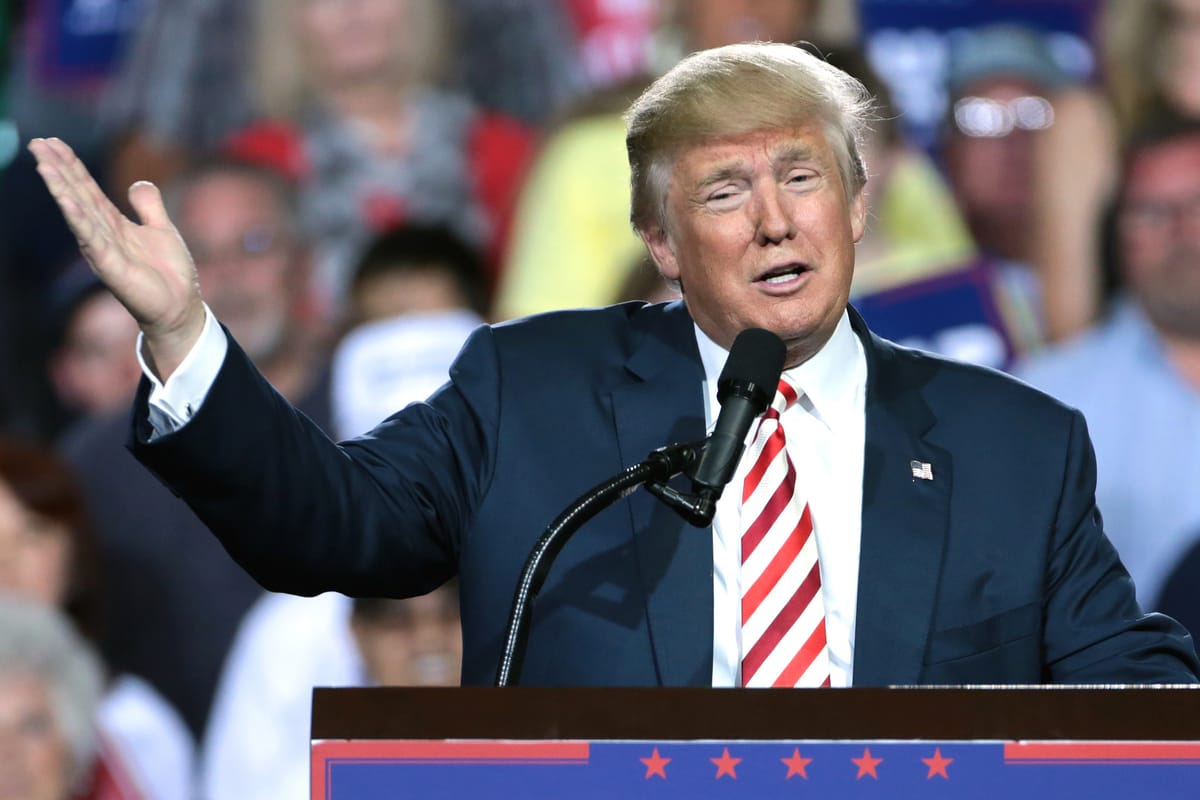Trump Administration Releases Details of $1.5 Trillion Infrastructure Plan Leveraging $200 Billion in Federal Funds
WASHINGTON, February 11, 2018 – After a year of promises, President Donald Trump on Monday is expected to unveil his long-awaited proposal for revamping the nation’s infrastructure. The plan, which was previewed by a senior White House official over the weekend, is designed to stimulate investment w
Andrew Feinberg

WASHINGTON, February 11, 2018 – After a year of promises, President Donald Trump on Monday is expected to unveil his long-awaited proposal for revamping the nation’s infrastructure. The plan, which was previewed by a senior White House official over the weekend, is designed to stimulate investment with an injection of limited federal funds and streamlining the permitting process.
Infrastructure is obviously a critical component to the functioning of our economy,” the official said. He called the current system “fundamentally broken” because of years of underinvestment and a permitting process that can take up to a decade before construction on infrastructure projects can begin.
“[T]he President’s vision is to have a permanent fix for the problems that plague us in terms of underinvesting and the length of the permitting process, and not just kick the can down the road and pass things over for a couple of years, which has been the habit in infrastructure policy for the last couple of decades.”
Is Trump infrastructure plan coming back to the forefront?
During the 2016 election, Trump often spoke of the nation’s crumbling bridges and roads. He pledged to help rebuild as President by bringing the know-how and experience he’d gained from decades working as a real estate executive building hotels and apartment complexes in numerous countries.
Many hoped that this experience would lead Trump to make an infrastructure package his first priority.
But the White House only touched lightly upon the subject during Trump’s first year. Last June, in an attempt at imposing message discipline by the communications division of the White House, Trump’s nascent administration tried its hand at highlighting infrastructure issues – particularly the difficulties associated with the federal permitting process – during something called “infrastructure week.” It was one of several similarly-themed weeks.
That week included the signing of an executive order meant to streamline the federal permitting process. But the week soon became dominated by coverage of Capitol Hill testimony by former FBI Director James Comey and other news relating to Trump’s decision to fire Comey.
Previously leaked document shows Trump administration plans to spend $1.5 trillion on infrastructure
Leaked documents indicate plans to spend $1.5 trillion on infrastructure projects. But the administration’s second bite at the infrastructure apple might disappoint those seeking large federal projects.
Although $1.5 trillion infrastructure plan would certainly rival the Obama administration’s American Reinvestment and Recovery Act, estimated at the time as $787 billion of new spending. The amount was later revised to $831 billion between 2009 and 2019.
But the Trump proposal envisions no new federal projects, contains no overarching plan for repairing, rebuilding or new construction projects, and gives nearly no attention to 21st century digital infrastructure components like fiber or wireless broadband.
Instead, Trump’s proposal will spend just $200 billion in federal funds – to be found in cost savings from other programs – on loans and block grants for mostly rural infrastructure projects.
Details of Trump administration infrastructure investment plans
The $1.5 trillion number, the official said, comes not from any rigorous attempt at projections but represents how state and local governments will respond to the program.
While it was once projected at $1 trillion, it was bumped up to half a trillion “because we’ve actually received a… more enthusiastic response than we anticipated from state and local governments coming to us and saying, ‘we have this project, we have funding identified, but we’d love to participate in incentives to get that match to help finish up the project and build the whole thing.’”
The hope, the senior White House official said, is that the $1.5 trillion in infrastructure investment will be realized by spending the $200 billion and having it stimulate states, localities, and the private sector to spend that much on infrastructure investments in the form of repairs and improvements to existing infrastructure as well as new construction projects.
The plan reserves one-half of the $200 billion — which the official referred to as an “incentives package” – for use as matching funds to be distributed to state and local governments as a reward for infrastructure spending.
“If they’re creating new revenue streams and they want to build something, we will partner with them to help them to match and fulfill that one final gap in terms of financing infrastructure.”
The fund will finance rail, water and transportation projects
The plan directs another 10 percent of the $200 billion, or $20 billion, toward expand current loan and private activity bond programs to finance rail, water and other transportation projects.
Still another $20 billion will be directed toward “transformative projects,” which the official defined as projects “that can lift the American spirit, that are the next-century-type of infrastructure as opposed to just rebuilding what we have currently.”
“That ensures that we’re not focusing on just patching up the infrastructure that we have currently, but will we also have a vision toward the future,” the official said.
Another $10 billion won’t actually go toward infrastructure projects, but will be set aside for a “capital financing fund” to help with “governmental accounting rules,” the official said. “In essence, it’s a just more responsible way for us to actually fund the office-building infrastructure that the federal government is building currently.”
Second-largest segment of funds, or $50 billion, will go to rural infrastructure
But the official confirmed that the plan sets aside the second-largest portion of funds of the $200 billion in federal spending – $50 billion – for rural infrastructure projects.
While the $100 billion “incentives package” will be spent as matching funds, the $50 billion directed specifically for rural states, which overwhelmingly supported Trump over Democrat Hillary Clinton in the 2016 election. This $50 billion will be distributed directly to rural governors in the form of block grants, “to allow governors to select what the priorities of infrastructure are in their respective states.”
While telecommunications projects of a “transformative nature” would theoretically be eligible to receive federal funding, the rural program is the only part of the plan for which broadband is specifically envisioned as a use case, the senior White House official said.
Previously announced rural broadband initiatives
Monday’s plan will not, however, be the Trump administration’s first foray into the world of rural broadband, as President Trump has previously acknowledged the need for expanded broadband access in rural America.
In January 2018, Trump addressed the American Farm Bureau convention in Nashville, Tennessee, and signed two executive actions meant to facilitate rural broadband deployment: An executive order for “Streamlining and Expediting Requests to Locate Broadband Facilities in Rural America” and a presidential memorandum for “Supporting Broadband Tower Facilities in Rural America and Federal Properties Managed by the Department of the Interior.”
The two actions would “provide broader and faster, and better internet coverage,” Trump said at the time.
Another previously-announced rural broadband initiative announced by the Trump administration intended to explore the use of federally-owned “dark fiber” – fiber that has been laid but is not currently in use – in order “to interconnect and provide service to communities that have not had access to broadband before,” National Economic Council Special Assistant for Technology, Telecommunications, and Cybersecurity Grace Koh said in January.
Compared to Obama, Trump administration shows lack of attention to telecommunications infrastructure
The lack of attention to broadband and other telecommunications infrastructure from Trump or his advisors compared to that given to brick-and-mortar projects may not be surprising when considering the president’s background as a builder.
Still, it remains noteworthy when contrasted with the Obama administration’s attention to broadband deployment and efforts to improve access and close the digital divide, which were the focus of several programs funded under the 2009 American Reinvestment and Recovery Act.
Under the Recovery Act, in which Congress pumped federal money into an economy still suffering from the effects of the 2008 financial crisis, the Obama administration distributed a combined $7.2 billion in loans and grants through the National Telecommunications and Information Administration’s Broadband Technology Opportunity Program and the U.S. Department of Agriculture Rural Utilities Service’s Broadband Incentives Program.
While the Trump infrastructure plan in theory makes a combined $60 billion available which could be used for broadband projects, none of the funds are set aside for such projects.
Potential state laws barring municipal broadband networks
In addition, jurisdictions in many of the same states that will be eligible to receive block grants under the rural infrastructure program would be prohibited from spending those funds on broadband projects, as they have laws in the books banning public funds from being spent to build or operate municipal broadband networks.
State legislatures enacted many of those laws at the behest of cable and internet providers, which often lobby for municipal broadband bans out of fears that such networks would cut into their customer base.
As to why the Trump administration’s plan lacked any specific focus on broadband networks or whether it would copy the ARRA’s inclusion of a “dig once” requirement to mandate that federally-funded projects include features to facilitate broadband deployment – including conduits in road projects – neither the White House nor the National Economic Council responded to queries on the subject by our deadline.
(Photo of Donald Trump in October 2016 by Gage Skidmore used with permission.)










Member discussion